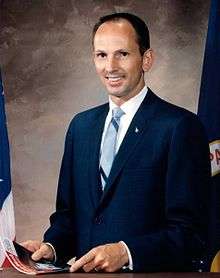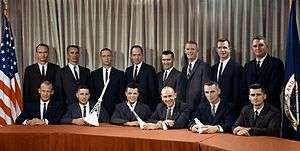Theodore Freeman
| Theodore C. Freeman | |
|---|---|
 | |
| NASA Astronaut | |
| Nationality | American |
| Status | Killed during training |
| Born |
February 18, 1930 Haverford, Pennsylvania, U.S. |
| Died |
October 31, 1964 (aged 34) Houston, Texas, U.S. |
Other names | Theodore Cordy Freeman |
Other occupation | Test pilot |
|
University of Delaware USNA, B.S. 1953 UMich, M.S. 1960 | |
| Rank | Captain, USAF |
| Selection | 1963 NASA Group 3 |
| Missions | None |
Theodore Cordy "Ted" Freeman (February 18, 1930 – October 31, 1964), (Capt, USAF), was an American aeronautical engineer, U.S. Air Force officer, test pilot, and NASA astronaut. He was killed in the crash of a T-38 jet, marking the first fatality among the NASA Astronaut Corps.
Biography
Early life and education
Freeman was born on February 18, 1930, in Haverford, Pennsylvania, and completed his secondary education in 1948. He attended the University of Delaware at Newark for one year, then entered the United States Naval Academy and graduated in 1953 with a Bachelor of Science degree. In 1960, he received a Master of Science degree in Aeronautical Engineering from the University of Michigan.
He was a Boy Scout and he earned the rank of First Class.[1]
Military and NASA career

| “ | "We don't look on this as dangerous work. It's about the most fascinating job I could imagine." | ” |
| — About his astronaut duties.[2] | ||
He took flight training at Hondo Air Force Base and Bryan Air Force Base, Texas and at Nellis Air Force Base, Nevada, getting his pilot wings in February 1955, shortly after being promoted to First Lieutenant. He then served in the Pacific and at George Air Force Base, California. He was promoted to Captain while pursuing his master's degree at the University of Michigan and then went to Edwards Air Force Base, California, in February 1960 as an aerospace engineer.
Freeman graduated from both the Air Force's Experimental Test Pilot and Aerospace Research Pilot School courses. He elected to serve with the Air Force. His last Air Force assignment was as a flight test aeronautical engineer and experimental flight test instructor at the ARPS at Edwards Air Force Base in the Mojave Desert.
He served primarily in performance flight testing and stability testing areas. He logged more than 3,300 hours flying time, including more than 2,400 hours in jet aircraft. Freeman was one of the third group of astronauts selected by NASA in October 1963. He was assigned the responsibility of aiding the development of boosters.[3]
On the morning of Saturday, October 31, 1964, Theodore Freeman was making a return flight from McDonnell-Douglas training facilities in St. Louis, MO. He was killed during final approach to landing at Ellington Air Force Base, Houston, Texas, when a goose flew into the port-side air intake of his NASA-modified T-38 Talon jet trainer causing immediate engine failure. The bird strike was plainly observed by two airmen on duty in the Ellington AFB Air Traffic Control Tower Cab. Flying shards of Plexiglas may have entered the jet engine during the crash. Within seconds of the goose strike, the plane pancaked short of the base perimeter fence onto a public highway and caused the plane to immediately and violently lose structural integrity. The two observers did not witness any evidence of Freeman ejecting from the stricken aircraft, but it was too close to the ground for a parachute to open properly in any event.
Personal life
Freeman was survived by his wife Faith Clark Freeman and one daughter, Faith Huntington. Faith Freeman first heard of her husband's death when a reporter came to her house: NASA subsequently ensured that in the case of future astronaut deaths, their families were informed by other astronauts as quickly as possible.[3] He is buried in Arlington National Cemetery.
Organizations
Freeman was a member of the American Institute of Aeronautics and Astronautics and the Society of Experimental Test Pilots.
Honors
The Clear Lake City-County Freeman Branch Library of the Harris County Public Library and Houston Public Library systems is named in memory of Freeman. An artificial island off Southern California is also named for him. This is one of the four "Astronaut Islands" built in Long Beach Harbor during the late 1960s as unsinkable platforms for oil drilling; the others were named Grissom, White and Chaffee, in honor of the astronauts killed in the Apollo 1 fire.[4][5] The Theodore C. Freeman Highway in Lewes, Delaware is named after him.
Books
A family-approved account of Freeman's life and career appears in the 2003 book Fallen Astronauts by space historians Colin Burgess and Kate Doolan.[6]
Oriana Fallaci's If the Sun Dies, a book on the early days of the American space program, features an account of Freeman.[7]
The Forgotten Astronauts by Codex Regius includes a brief account on the circumstances of Freeman's death.[8]
Physical description
- Weight: 139 lb (63 kg)
- Height: 5 ft 10½ in (1.79 m)
- Hair: Brown
- Eyes: Brown[9]
See also
References
- ↑ Theodore C. Freeman at scouting.org
- ↑ Theodore C. Freeman's quotation
- 1 2 Collins, Michael (2001). Carrying the Fire: An Astronaut's Journeys. Cooper Square Press. ISBN 0-8154-1028-X.
- ↑ Brittingham, Hazel (March 21, 2004). "Fallen Astronauts: Book Review". Michael Robert Patterson. Retrieved May 16, 2012.
- ↑ "City of Long Beach Enterprise Zone" (PDF). City of Long Beach. Retrieved May 16, 2012.
- ↑ Burgess, Colin; Doolan, Kate; Vis, Bert (2003). Fallen Astronauts: Heroes Who Died Reaching for the Moon. Lincoln and London: University of Nebraska Press. ISBN 0-8032-6212-4.
- ↑ Fallaci, Oriana (1966). If the Sun Dies. New York: Atheneum.
- ↑ Codex Regius (2014). The Forgotten Astronauts:A rarely told Chapter of American Spaceflight History. ISBN 1-4996-1012-2.
- ↑ Theodore C. Freeman's physical description
External links
| Wikimedia Commons has media related to Theodore Freeman. |
- Freeman's official NASA biography
- Astronautix biography of Theodore C. Freeman
- Spacefacts biography of Theodore C. Freeman
- Theodore C. Freeman at Astronauts Memorial page
- Freeman page at Astronaut Memorial
- Arlington National Cemetery biography and photos
- Theodore Freeman at Find a Grave
